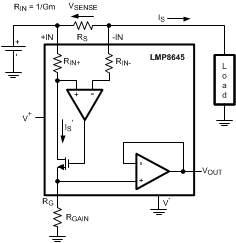SNOSB29H November 2009 – May 2022 LMP8645 , LMP8645HV
PRODUCTION DATA
- 1 Features
- 2 Applications
- 3 Description
- 4 Revision History
- 5 Pin Configuration and Functions
- 6 Specifications
- 7 Detailed Description
- 8 Application and Implementation
- 9 Power Supply Recommendations
- 10Layout
- 11Device and Documentation Support
- 12Mechanical, Packaging, and Orderable Information
Package Options
Mechanical Data (Package|Pins)
- DDC|6
Thermal pad, mechanical data (Package|Pins)
Orderable Information
7.1.1 Theory of Operation
 Figure 7-1 Current Monitor Example Circuit
Figure 7-1 Current Monitor Example CircuitAs seen in Figure 7-1, the current flowing through the shunt resistor ( RS) develops a voltage drop equal to VSENSE across RS. The resulting voltage at the –IN pin will now be less than +IN pin proportional to the VSENSE voltage.
The sense amplifier senses this indifference and increases the gate drive to the MOSFET to increase IS′ current flowing through the RIN+ string until the amplifer inputs are equal. In this way, the voltage drop across RIN+ now matches the votlage drop across VSENSE.
The RIN resistors are trimmed to a nominal value of 5 kΩ each. The current IS′ flows through RIN+ , the MOSFET, and RGAIN to ground. The IS′ current generates the voltage VG across RGAIN. The gain is created bythe ratio of RGAIN and RIN.
A current proportional to IS is generated according to the following relation:
where
- RIN = 1 / Gm
This current flows entirely in the external gain resistor developing a voltage drop equal to:
This voltage is buffered and presented at the output with a very low output impedance allowing a very easy interface to other devices (ADC, μC…).
where
- G = RGAIN / RIN